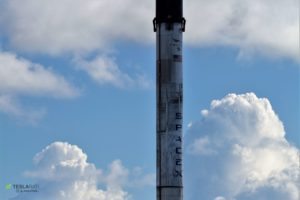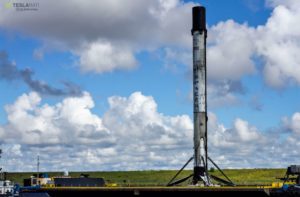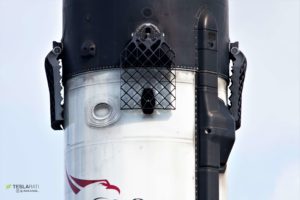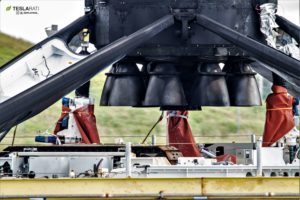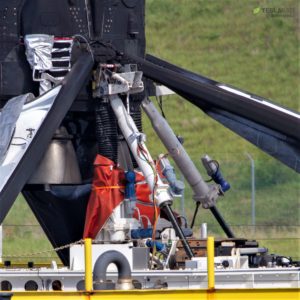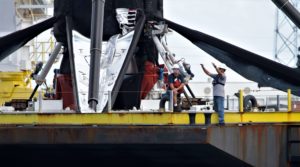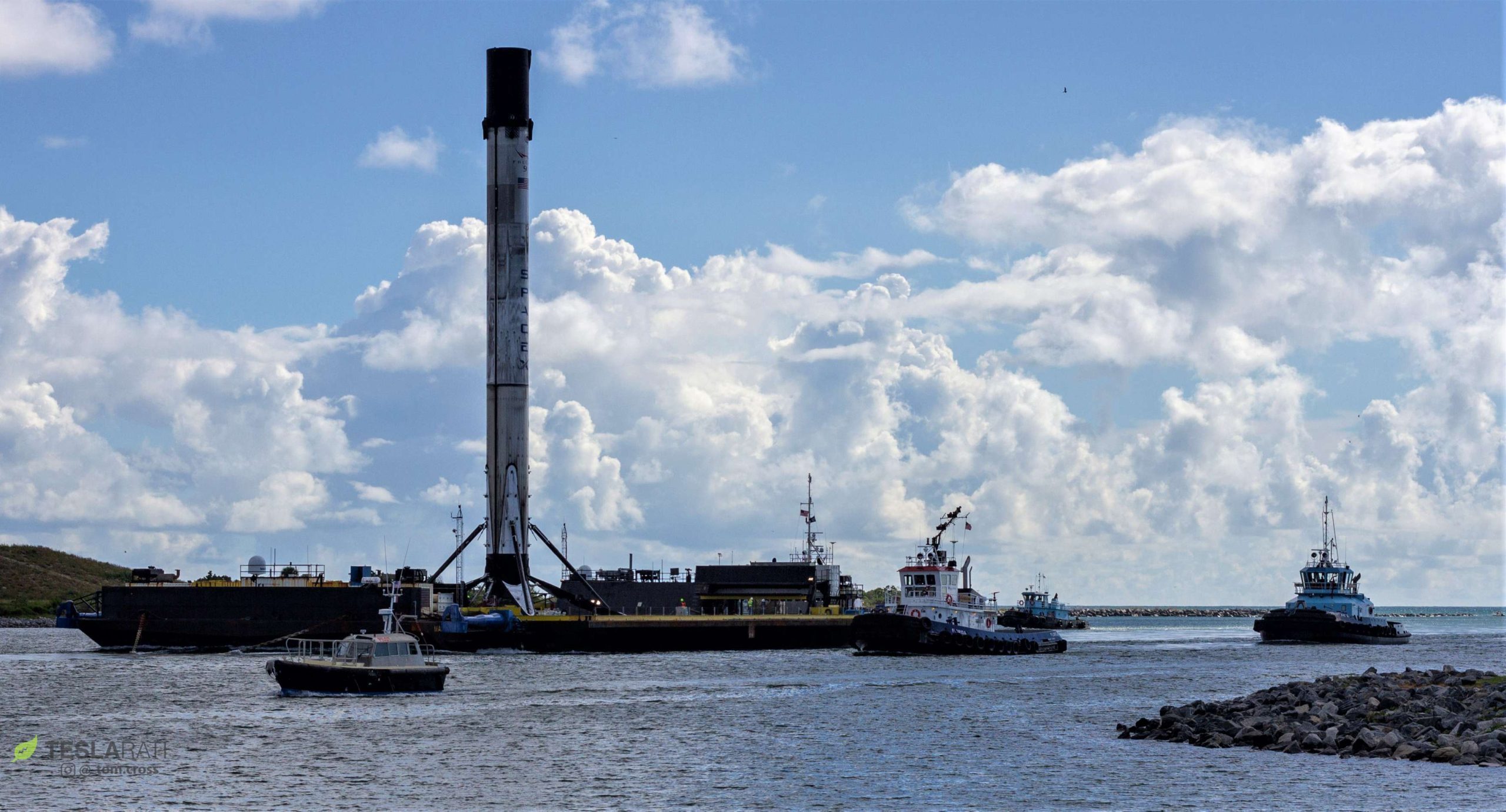
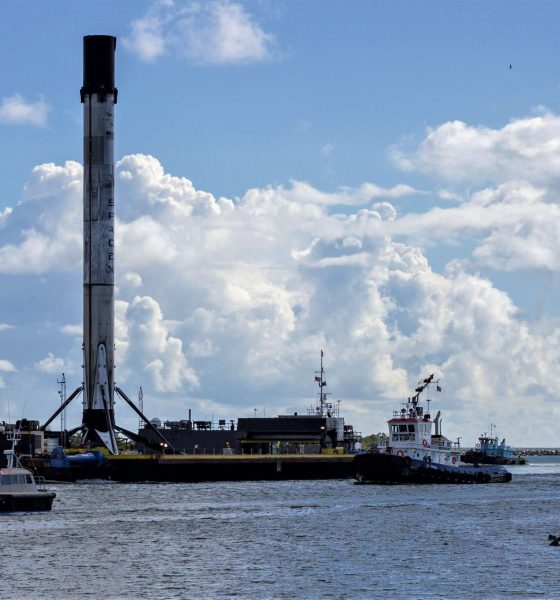
News
SpaceX recovers another Falcon 9 Block 5 booster as reusable rocket fleet grows
Following the upgraded rocket family’s fifth successful launch since its May 2018 debut, SpaceX has returned another Falcon 9 Block 5 booster to land after a drone ship recovery.
Falcon 9 B1049 is now the fourth flight-proven Block 5 booster in SpaceX’s flightworthy rocket fleet, all of which can be expected to fly numerous orbital-class missions before being retired or expended. Despite a relatively slow September and October ahead of SpaceX’s launch manifest, the final two months of 2018 could be quite busy, and will in part rely on the reusability of SpaceX’s Block 5 rockets.
https://twitter.com/_TomCross_/status/1039906864341966848
Thankfully, Falcon 9 Block 5’s reusability prospects are looking extremely positive according to September 11 comments from SpaceX President and COO Gwynne Shotwell, who stated that the rockets (like B1049 today) were returning from launch in even better condition than was initially expected. As a result, it should be imminently possible for SpaceX to refly the same Falcon 9 Block 5 booster after as few as four weeks of refurbishment, with the goal to eventually cut the required maintenance so much that a given booster can refly in ~24 hours.
Shotwell: Falcon 9 first stages come back in much better shape than anticipated. Have refurbishment time down to four weeks; goal is still a one-day turnaround next year. #WSBW
— Jeff Foust (@jeff_foust) September 11, 2018
Still, thanks to the higher-energy geostationary transfer orbit (GTO) missions all Block 5 boosters have thus flown on, reentry and recovery conditions wind up being far less forgiving, suggesting that what Shotwell, Musk, and SpaceX are really referring to when discussing 24-hour reusability is the rapid reuse of Block 5 boosters after low-energy launches to orbits far lower than GTO and lighter payloads in tow.
In particular, Falcon 9 Block 5 launches like Cargo Dragon resupply missions and other miscellaneous smaller satellites should not only leave the boosters in exceptionally pristine condition, but they will also intrinsically leave the rocket just a handful of miles (at most) away from the launch pad, a clear advantage to any truly rapid reuse. Drone ship-recovery Falcon 9s like B1049’s, on the other hand, require at least several days to be towed back to port, fundamentally limiting booster turnaround time for high-energy launches like Telstar 18V, Telstar 19V, Telkom 4, Iridium-7, and Bangabandhu-1.
- Falcon 9 Block 5 booster B1049 returned to Port Canaveral today, ~60 hours after launch. (Tom Cross)
- Falcon 9 Block 5 booster B1049 returned to Port Canaveral today, ~60 hours after launch. Falcon 9 is dramatically cheaper than the aging Delta II. (Tom Cross)
- SpaceX’s most recent Florida launch was in early September. (Tom Cross)
- Falcon 9 B1049’s Merlin engines and octaweb. (Tom Cross)
- Recovery robot Octagrabber seen attached to B1049. (Tom Cross)
- A sense of scale. (Tom Cross)
SpaceX’s next launch – Argentinian Earth observation satellite SAOCOM-1A, NET October 7 – will feature a number of critical milestones, including the second reuse of a Falcon 9 Block 5 booster, the first truly light and low-energy launch for the upgraded rocket, the first Landing Zone recovery for Block 5, and the inaugural debut of a dedicated Californian rocket landing zone scarcely a few thousand feet from SpaceX’s Vandenberg launch pad.
Although SAOCOM-1A is likely to be the only SpaceX launch in October, November may very well feature the first launch of Crew Dragon, an uncrewed demonstration mission that will see the spacecraft dock with the International Space Station to ensure that it’s ready for astronauts. SpaceX’s 19th Cargo Dragon launch is also expected to occur as early as December 1st.
For prompt updates, on-the-ground perspectives, and unique glimpses of SpaceX’s rocket recovery fleet check out our brand new LaunchPad and LandingZone newsletters!

Elon Musk
Elon Musk’s X will start using a Tesla-like software update strategy
The initiative seems designed to accelerate updates to the social media platform, while maintaining maximum transparency.

Elon Musk’s social media platform X will adopt a Tesla-esque approach to software updates for its algorithm.
The initiative seems designed to accelerate updates to the social media platform, while maintaining maximum transparency.
X’s updates to its updates
As per Musk in a post on X, the social media company will be making a new algorithm to determine what organic and advertising posts are recommended to users. These updates would then be repeated every four weeks.
“We will make the new 𝕏 algorithm, including all code used to determine what organic and advertising posts are recommended to users, open source in 7 days. This will be repeated every 4 weeks, with comprehensive developer notes, to help you understand what changed,” Musk wrote in his post.
The initiative somewhat mirrors Tesla’s over-the-air update model, where vehicle software is regularly refined and pushed to users with detailed release notes. This should allow users to better understand the details of X’s every update and foster a healthy feedback loop for the social media platform.
xAI and X
X, formerly Twitter, has been acquired by Elon Musk’s artificial intelligence startup, xAI last year. Since then, xAI has seen a rapid rise in valuation. Following the company’s the company’s upsized $20 billion Series E funding round, estimates now suggest that xAI is worth tens about $230 to $235 billion. That’s several times larger than Tesla when Elon Musk received his controversial 2018 CEO Performance Award.
As per xAI, the Series E funding round attracted a diverse group of investors, including Valor Equity Partners, Stepstone Group, Fidelity Management & Research Company, Qatar Investment Authority, MGX, and Baron Capital Group, among others. Strategic partners NVIDIA and Cisco Investments also continued support for building the world’s largest GPU clusters.
News
Tesla FSD Supervised wins MotorTrend’s Best Driver Assistance Award
The decision marks a notable reversal for the publication from prior years, with judges citing major real-world improvements that pushed Tesla’s latest FSD software ahead of every competing ADAS system.

Tesla’s Full Self-Driving (Supervised) system has been named the best driver-assistance technology on the market, earning top honors at the 2026 MotorTrend Best Tech Awards.
The decision marks a notable reversal for the publication from prior years, with judges citing major real-world improvements that pushed Tesla’s latest FSD software ahead of every competing ADAS system. And it wasn’t even close.
MotorTrend reverses course
MotorTrend awarded Tesla FSD (Supervised) its 2026 Best Tech Driver Assistance title after extensive testing of the latest v14 software. The publication acknowledged that it had previously criticized earlier versions of FSD for erratic behavior and near-miss incidents, ultimately favoring rivals such as GM’s Super Cruise in earlier evaluations.
According to MotorTrend, the newest iteration of FSD resolved many of those shortcomings. Testers said v14 showed far smoother behavior in complex urban scenarios, including unprotected left turns, traffic circles, emergency vehicles, and dense city streets. While the system still requires constant driver supervision, judges concluded that no other advanced driver-assistance system currently matches its breadth of capability.
Unlike rival systems that rely on combinations of cameras, radar, lidar, and mapped highways, Tesla’s FSD operates using a camera-only approach and is capable of driving on city streets, rural roads, and freeways. MotorTrend stated that pure utility, the ability to handle nearly all road types, ultimately separated FSD from competitors like Ford BlueCruise, GM Super Cruise, and BMW’s Highway Assistant.
High cost and high capability
MotorTrend also addressed FSD’s pricing, which remains significantly higher than rival systems. Tesla currently charges $8,000 for a one-time purchase or $99 per month for a subscription, compared with far lower upfront and subscription costs from other automakers. The publication noted that the premium is justified given FSD’s unmatched scope and continuous software evolution.
Safety remained a central focus of the evaluation. While testers reported collision-free operation over thousands of miles, they noted ongoing concerns around FSD’s configurable driving modes, including options that allow aggressive driving and speeds beyond posted limits. MotorTrend emphasized that, like all Level 2 systems, FSD still depends on a fully attentive human driver at all times.
Despite those caveats, the publication concluded that Tesla’s rapid software progress fundamentally reshaped the competitive landscape. For drivers seeking the most capable hands-on driver-assistance system available today, MotorTrend concluded Tesla FSD (Supervised) now stands alone at the top.
News
Elon Musk’s Grokipedia surges to 5.6M articles, almost 79% of English Wikipedia
The explosive growth marks a major milestone for the AI-powered online encyclopedia, which was launched by Elon Musk’s xAI just months ago.

Elon Musk’s Grokipedia has grown to an impressive 5,615,201 articles as of today, closing in on 79% of the English Wikipedia’s current total of 7,119,376 articles.
The explosive growth marks a major milestone for the AI-powered online encyclopedia, which was launched by Elon Musk’s xAI just months ago. Needless to say, it would only be a matter of time before Grokipedia exceeds English Wikipedia in sheer volume.
Grokipedia’s rapid growth
xAI’s vision for Grokipedia emphasizes neutrality, while Grok’s reasoning capabilities allow for fast drafting and fact-checking. When Elon Musk announced the initiative in late September 2025, he noted that Grokipedia would be an improvement to Wikipedia because it would be designed to avoid bias.
At the time, Musk noted that Grokipedia “is a necessary step towards the xAI goal of understanding the Universe.”
Grokipedia was launched in late October, and while xAI was careful to list it only as Version 0.1 at the time, the online encyclopedia immediately earned praise. Wikipedia co-founder Larry Sanger highlighted the project’s innovative approach, noting how it leverages AI to fill knowledge gaps and enable rapid updates. Netizens also observed how Grokipedia tends to present articles in a more objective manner compared to Wikipedia, which is edited by humans.
Elon Musk’s ambitious plans
With 5,615,201 total articles, Grokipedia has now grown to almost 79% of English Wikipedia’s article base. This is incredibly quick, though Grokipedia remains text-only for now. xAI, for its part, has now updated the online encyclopedia’s iteration to v0.2.
Elon Musk has shared bold ideas for Grokipedia, including sending a record of the entire knowledge base to space as part of xAI’s mission to preserve and expand human understanding. At some point, Musk stated that Grokipedia will be renamed to Encyclopedia Galactica, and it will be sent to the cosmos.
“When Grokipedia is good enough (long way to go), we will change the name to Encyclopedia Galactica. It will be an open source distillation of all knowledge, including audio, images and video. Join xAI to help build the sci-fi version of the Library of Alexandria!” Musk wrote, adding in a later post that “Copies will be etched in stone and sent to the Moon, Mars and beyond. This time, it will not be lost.”
